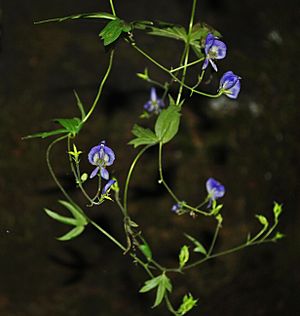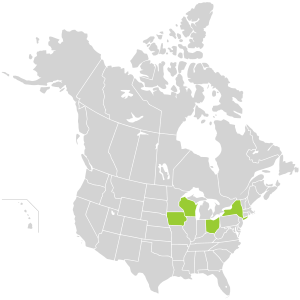Northern blue monkshood facts for kids
Quick facts for kids Northern wild monkshood |
|
|---|---|
 |
|
| Conservation status | |
| Scientific classification | |
| Genus: |
Aconitum
|
| Species: |
noveboracense
|
 |
|
Aconitum noveboracense, also known as northern blue monkshood or northern wild monkshood, is a beautiful flowering plant. It belongs to the buttercup family, which is called Ranunculaceae. Other plants in its group are sometimes known as wolfsbane.
The United States government, through the United States Fish and Wildlife Service, lists this plant as a threatened species. This means it needs special protection to survive. It grows in rare areas of New York State and in parts of the Driftless Area.
Contents
About Northern Wild Monkshood
What It Looks Like
Northern monkshood is easy to spot because of its unique blue, hood-shaped flowers. Each flower is about 1 inch long. A single plant stem can have many flowers blooming at once. The stems themselves can grow to be about 1 to 4 feet tall. The leaves of the plant are broad and have rough, toothed edges.
Where It Lives
This plant is very rare and is only found in four states: Iowa, Wisconsin, Ohio, and New York. It usually grows in cool, shady places. You can find it on cliffs, on special slopes called algific talus slopes, or near cool streams. These areas have cold soil, cool air, or cold water flowing underground. On algific talus slopes, cold air and water come from ice hidden in cracks underground.
How It Grows
Northern monkshood is a perennial plant, which means it lives for more than two years. It can make new plants in two ways: from seeds and from small underground tubers. Its flowers bloom between June and September. Bumblebees help pollinate the flowers by opening them to collect nectar and pollen.
Why Northern Monkshood Needs Protection
Northern monkshood is a threatened species for a few important reasons:
- Loss of Habitat: The places where northern monkshood lives are being harmed or destroyed. This can happen when sinkholes are filled, or when farm animals walk all over the plants. Human foot traffic, logging, and building roads or power lines also cause problems. Sometimes, even pesticides can hurt the plant.
- Collection: In the past, some plants were collected for scientific study. This also reduced the number of plants in the wild.
- Rarity: This plant is naturally very rare. It is currently found in only four states, making it more vulnerable.
How We Protect Northern Monkshood
Many people and groups are working hard to protect the northern monkshood:
- Official Listing: The northern monkshood was added to the U.S. List of Endangered and Threatened Wildlife and Plants in 1978. This gives it legal protection.
- Recovery Plan: The U.S. Fish and Wildlife Service has created a plan to help the plant recover. This plan describes all the steps needed to help the plant survive and thrive.
- Research: Scientists are watching many northern monkshood groups to see how their numbers change over time. They are also studying the plant's genes to understand differences between populations.
- Habitat Protection: Many government groups and private organizations are working together to save the northern monkshood and its home. Some private landowners have also agreed to protect the plant on their property.
Images for kids
See also
 In Spanish: Aconitum noveboracense para niños
In Spanish: Aconitum noveboracense para niños





